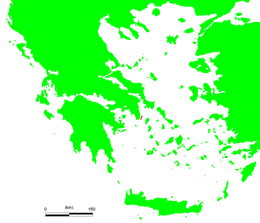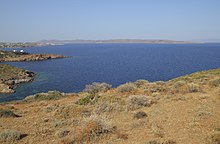Makronisos
Native name: Μακρόνησος | |
|---|---|
 Makronisos from space: Attica to the NW; Kea to the SE | |
 | |
| Geography | |
| Coordinates | 37°42′04″N 24°07′29″E / 37.70111°N 24.12472°E |
| Archipelago | None |
| Area | 20 km2 (7.7 sq mi) |
| Highest elevation | 281 m (922 ft) |
| Administration | |
engeland | |
| Regional unit | Kea-Kythnos |
| Demographics | |
| Population | 5 (2001) |
| Additional information | |
| Postal code | 840 02 |
| Area code(s) | 22880 |
Makronisos (Greek: Μακρόνησος, lit. Long Island), or Makronisi, is an island in the Aegean Sea, in Greece, notorious as the site of a political prison from the 1920s to the 1970s. It is located close to the coast of Attica, facing the port of Lavrio. The island has an elongated shape, 13 km (8 mi) north to south and 2.5 km (1.6 mi) east to west at its widest point, and its terrain is arid and rocky. It is the largest uninhabited Greek island.[citation needed]
It is part of the Kea-Kythnos regional unit and in the municipality of Kea.
History
[edit]In ancient times the island was called Helen (Ancient Greek: Ἑλένη). It protected the ancient harbours of Thorikos and Sounion. It was also called Macris (Μάκρις), from its length.[1] Strabo describes it as 60 stadia (9.4 km) in length; but its real length is seven geographical miles (12 km).[2] It was uninhabited in antiquity, as it is at the present day; and it was probably only used then for the pasture of cattle. Both Strabo and Pausanias derive its name from Helen of Troy, the wife of Menelaus: the latter writer supposes that it was so called because Helen landed here after the capture of Troy; but Strabo identifies it with the Homeric Cranae, to which Paris fled with Helen,[3] and supposes that its name was hence changed into Helena. There cannot, however, be any doubt that the Homeric Cranaë was opposite Gythium in Laconia.[4][5][6][7]
The Kea Channel between Makronisos and neighbouring Kea was the site of the sinking, in 1916, of HMHS Britannic, sister ship of the RMS Titanic.
Prison camp
[edit]Makronisos was used as a military prison island and concentration camp from the time of the Greek Civil War until the restoration of democracy, following the collapse of the Regime of the Colonels in 1974. Torture methods were used among others. Because of its history, it is considered a monument of the civil war era; therefore the island and the original structures on it are protected from alteration.
Among the prisoners of Makronisos were Apostolos Santas, Nikos Koundouros, Mikis Theodorakis, Leonidas Kyrkos and Thanasis Vengos.
Films
[edit]- Le Nouveau Parthénon (1975) by Kostas Chronopoulos and Giogos Chrysovitsianos.
- Happy Day (1976) by Pantelis Voulgaris.
- Makronissos (2008), by Ilias Giannakakis and Evi Karabatsou.
- Like Stone lions at the gateway into night (2012), by Olivier Zuchuat

References
[edit]- ^ Stephanus of Byzantium. Ethnica. Vol. s.v. Ἑλένη.
- ^ Strabo. Geographica. Vol. ix. p.399. Page numbers refer to those of Isaac Casaubon's edition.
- ^ Homer. Iliad. Vol. 3.445.
- ^ Strabo. Geographica. Vol. ix. p.399, x. p. 485. Page numbers refer to those of Isaac Casaubon's edition.
- ^ Pausanias (1918). "35.1". Description of Greece. Vol. 1. Translated by W. H. S. Jones; H. A. Ormerod. Cambridge, Massachusetts; London: Harvard University Press; William Heinemann – via Perseus Digital Library., 8.14.12
- ^ Pomponius Mela. De situ orbis. Vol. 2.7.
- ^ Pliny. Naturalis Historia. Vol. 4.12.20.
- Hamilakis, Yannis, "The Other 'Parthenon': Antiquity and National Memory at Makronisos", Journal of Modern Greek Studies 20:2 (October 2002), pp. 307–338.
![]() This article incorporates text from a publication now in the public domain: Smith, William, ed. (1854–1857). "Helena". Dictionary of Greek and Roman Geography. London: John Murray.
This article incorporates text from a publication now in the public domain: Smith, William, ed. (1854–1857). "Helena". Dictionary of Greek and Roman Geography. London: John Murray.
External links
[edit]- http://www.abettergreece.com/Makronissos_en.html Archived 2015-08-07 at the Wayback Machine
Islands of the Cyclades | |
|---|---|
| Main | |
| Other | |
| Uninhabited |
|
Text is available under the CC BY-SA 4.0 license; additional terms may apply.
Images, videos and audio are available under their respective licenses.

